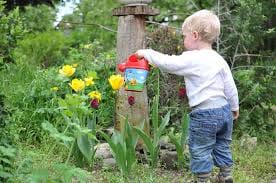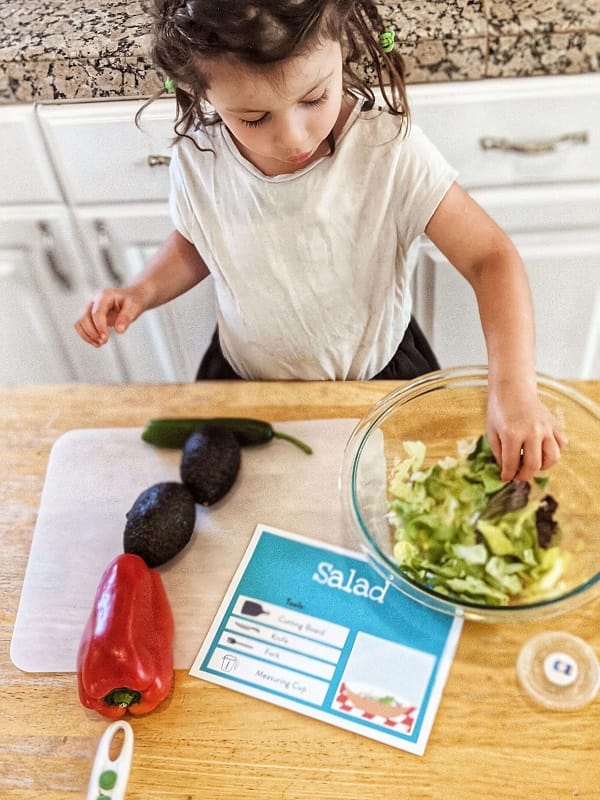Getting kids to eat their vegetables is hard. At Kitch’N Giggles, we’re all about using cooking as a hands-on way to get kids excited about veggies. Spending time together in the kitchen is a great way to help teach kids healthy eating habits, but it’s far from the only way. We’ve compiled a list from experts on ways to expose kids to vegetables without setting foot in the kitchen.
Playing with Food
Not food on your plate, but play food is an excellent way to expose kids to vegetables. Shari Raymond, founder of Milton & Goose, explains why play kitchens are one of the best tools for teaching kids to get a little more adventurous at the dinner table.
What kids learn by playing with food
Behind their pint-sized sinks and pared-down ovens, play kitchens are a powerful educational tool. It’s a way for kids to learn about, engage with, and embrace new and varied foods.
Exposure to New Foods
Any average toddler worth their weight in Cheerios can name common foods like milk, butter, bread, and apples. But how many can identify radishes, green onions, and leeks? I’d have to guess it’s far fewer. Enter play food. These days, you can find felt kale, rubber carrots, and wooden goat cheese in varieties that would round out even the most respectable farmer’s market. It’s this food literacy that lays the foundation for future foodies. If they know what it is, they might be more likely to give it a try down the line.
Low-Stress learning environment
One of the beautiful things about play kitchens is that the stakes are very low. Faucets can’t run over, eggs won’t burn, and a neglected piece of bread in the oven won’t start a kitchen fire. In short, it’s a carefree way for kids to interact with food. It also doesn’t hurt that they can handle everything from cookies and crackers to kale and chicken without the pressure of having to eat a forkful of it minutes later.
Cooking
On a recent Sunday morning, my four-year-old son took my meal order: a smoothie, two scrambled eggs, and a green salad. He dashed into his play kitchen and whipped up my meal in a head-spinning 20 seconds and then delightedly watched me pretend my way through each delicious morsel. He was thrilled to be the chef and I the willing patron. Does this help him appreciate the hard work I put into what I make for him in the real kitchen? The jury’s still out, but I like to think so.
Plant your own garden
Gardening is the precursor to cooking. What better way to teach your kids all about vegetables than to plant some yourself. It’s a little daunting, but Christy Wilhelmi, founder of Gardenerd.com and author of Gardening for Geeks shares her excellent tips.

Tips for Gardening with Kids
Start Small
If you are new to gardening, this is not the time to convert your entire yard into a mini-farm. Start with a planter bed or two, or even smaller—a couple of pots. Choose pots that are at least 12” deep to give plants room to develop strong roots.
Add Plenty of Compost
Garden soil is either very clay (doesn’t drain well, very difficult to dig) or very sandy (drains too well, dries out quickly but is easy to dig). Compost is the solution to both problems. Put down several inches of organic compost and dig it into the top four to six inches of soil. In pots, buy good quality potting soil that contains compost at a nursery. Start a compost bin for your kitchen scraps instead of throwing them in the landfill. Home made compost grows great plants!
Pick your Plants
Choose 3 or 4 plants to grow and give kids the assignment of researching how to care for them. For a better chance at success, find plants that grow in full sun (at least six hours per day) or partial sun (4-6 hours) depending on your sun exposure. All veggies and herbs do well in full sun, and for partial sun, choose greens like lettuces, Swiss chard, and kale. Strawberries and some herbs, like cilantro, parsley, oregano, and thyme tolerate partial sun as well.
No Patience? No Problem
Kids (and adults) like to see results quickly. Here are a few veggies that grow well from seed and give you more bang for the buck:
- Radishes – they sprout in three to seven days and can be harvested in about a month.
- Arugula – although it may be an acquired taste for kids, it also sprouts three to seven days and you can start harvesting outer leaves within a month of planting.
- Peas – they may take longer to grow, but they climb up a trellis and can be eaten straight out of the garden. They are the perfect garden snack.
Take them Shopping
We’re already grocery shopping anyway, why not turn it into an educational experience? Bringing kids along for a grocery run is another great way to build up that exposure.

How to Grocery Shop with Kids
Grocery shopping with kids is an excellent way to expose young children to the world of the grocery store, to teach them that food doesn’t just appear on your door step from Amazon and to show them the planning it takes to serve healthy meals.
On the downside, running errands with a little one in tow does require more snacks, more bathroom breaks and a lot more patience. Here are some tips on bringing your child along on a grocery run.
DO:
- Try to bring as few children as possible. It’s much easier to shop with 1 kid rather than 3. And the smaller they are, the better. Once they can walk around the store by themselves, it can get a little trickier to keep an eye on everyone.
- Go to a farmers market, or other shopping experience that provides samples. This also makes it more fun for you. Also it’s a great way to expose your kids to new vegetables that they may not be familiar with. You can’t beat the taste of fresh farmers market produce.
- Bring a game or activity. The USDA has several games to engaged kids while they’re running errands. Or you can make one up yourself.
- Avoid shopping when they are cranky, tired, hungry etc. This is actually quite tricky and could be a very valid reason to save all your errands for after bedtime.
- Bring snacks. Or they will just eat those blueberries while you shop you will show up at the register with an empty container. Trust me.
DON’T
- Do all of your shopping with your kids. It’s great to bring them along for a quick run to grab some fresh basil or bread. They get the exposure and it’s over before they can start complaining. It’s much much harder to have them sit patiently while you search the aisles for that pasta sauce everyone liked last week.
- Give in to their demands. It’s super tempting to cave into their requests after they make it 30 times in a row. Even more tempting if there is crying or screaming involved. But hold your course. Marketers are well aware of how much kids influence their parents’ shopping decisions and use that to their advantage. Ever wonder why there’s so much candy at the check-out line placed just about 3 feet off the ground?
- Take them if it’s not working. In an ideal world, we’d all peacefully shop for farm-fresh produce, our delightful children skipping happily by our sides. But this is real life, and young kids may just not be ready for a trip to the grocery store. If you find that bringing your kids along causes more problems then it’s worth, then don’t. There are plenty of other ways to get them involved in food prep.
TL;DR
Exposing your kids to vegetables doesn’t have to be a fight. Especially if you’re ready to extend your exposure beyond the table. Play food, gardening and grocery shopping are all excellent ways to help get your little eaters excited about eating their veggies.
Leave me a comment and let me know your favorite way to get your kids eager to eat vegetables.




